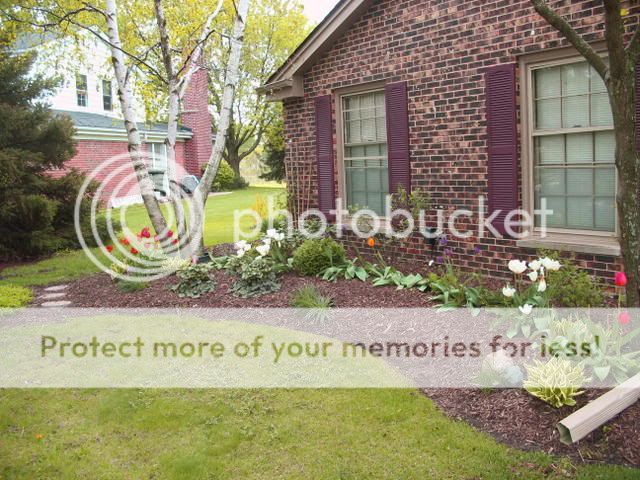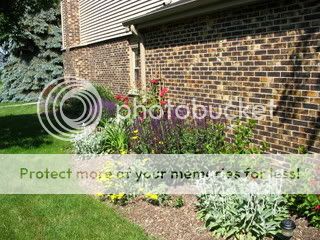
Maybe it’s “gardener’s block”—I don’t know. But I’ve struggled with what to put in here. Part of the problem is that I want fairly constant color, since it’s in the front. However, it's tough to find shade-loving perennials that will provide the bold color I desire. I’ve been filling in with impatiens and begonias for now, but eventually hope to have a mix of perennials that will take turns providing interest. Without the annuals, this bed would be a dark, shadowy hole most of the summer.
The other problem is that everything I have put in is still pretty small. If I can just be patient, I think it will look better some day. Here’s what I have so far. In the center is a chokeberry (Aronia arbutifolia ‘Brilliantissima’). It has pretty white flowers in spring, followed by red leaves in the fall. In winter its red berries stand out beautifully against the snow. It will eventually reach four feet by eight feet, which will help fill out the bed.

At either end are the two catawbiense rhododendrons I mentioned in my last post, one a ‘Nova Zembla’, with huge, velvety-red buds that open to deep pink, and ‘Boursault’, which is lavender-pink. They provide a nice jolt of color in the spring, along with a smattering of tulips and other bulbs, and their large, evergreen leaves make a nice backdrop the rest of the year.
Scattered in between are a few other small shrubs, including dwarf Korean lilac (Syringa meyeri ‘Palibin’), bird’s nest spruce (Picea abies ‘Nidiformis’), and an ‘Endless Summer’ hydrangea. The hydrangea took a couple years to settle in, but is doing well now, though my alkaline soil makes it look more like its cousin, the pink-tinged ‘Blushing Bride.’

When we moved here, there was a dwarf Alberta spruce in the center (which I pulled out after half of it turned brown) and three globe arborvitaes. I think there had been a fourth arborvitae at one time, two on each side of the spruce. (I kept one of the three leftovers where it was, and moved one elsewhere; the third died the second year we were here.) Existing trees on each end are paper birch and Amur maple. There’s also a huge green ash on the parkway nearby, and full-grown Austrian pine and Colorado blue spruce to one side, which quickly slurp up any moisture this area gets.

I’ve kept the variegated hostas left by Mr. Previous Owner, and have added a couple of golden ones, as well as Heuchera ‘Green Spice.’ Three ‘Bridal Veil’ astilbes will move to a moister location in the spring. They have not thrived here.

I planted a soft pink, thornless ‘Zephirine Drouhin’ climbing rose at the partly sunny, southeast corner of the garage, since she is supposed to do fine in low-light conditions, but I think she died back to the root stock last winter: She came in short and shrubby instead of tall and leggy, and never bloomed. I’ll probably replace her in the spring. Next to the rose is a deep red ‘Niobe’ clematis, which also does well with limited sun.
I guess I’m happy with most of what is here now, but have many gaps to fill. Now if spring would just hurry up and get here so I can go to work!

At either end are the two catawbiense rhododendrons I mentioned in my last post, one a ‘Nova Zembla’, with huge, velvety-red buds that open to deep pink, and ‘Boursault’, which is lavender-pink. They provide a nice jolt of color in the spring, along with a smattering of tulips and other bulbs, and their large, evergreen leaves make a nice backdrop the rest of the year.
Scattered in between are a few other small shrubs, including dwarf Korean lilac (Syringa meyeri ‘Palibin’), bird’s nest spruce (Picea abies ‘Nidiformis’), and an ‘Endless Summer’ hydrangea. The hydrangea took a couple years to settle in, but is doing well now, though my alkaline soil makes it look more like its cousin, the pink-tinged ‘Blushing Bride.’

When we moved here, there was a dwarf Alberta spruce in the center (which I pulled out after half of it turned brown) and three globe arborvitaes. I think there had been a fourth arborvitae at one time, two on each side of the spruce. (I kept one of the three leftovers where it was, and moved one elsewhere; the third died the second year we were here.) Existing trees on each end are paper birch and Amur maple. There’s also a huge green ash on the parkway nearby, and full-grown Austrian pine and Colorado blue spruce to one side, which quickly slurp up any moisture this area gets.

I’ve kept the variegated hostas left by Mr. Previous Owner, and have added a couple of golden ones, as well as Heuchera ‘Green Spice.’ Three ‘Bridal Veil’ astilbes will move to a moister location in the spring. They have not thrived here.

I planted a soft pink, thornless ‘Zephirine Drouhin’ climbing rose at the partly sunny, southeast corner of the garage, since she is supposed to do fine in low-light conditions, but I think she died back to the root stock last winter: She came in short and shrubby instead of tall and leggy, and never bloomed. I’ll probably replace her in the spring. Next to the rose is a deep red ‘Niobe’ clematis, which also does well with limited sun.
I guess I’m happy with most of what is here now, but have many gaps to fill. Now if spring would just hurry up and get here so I can go to work!

















